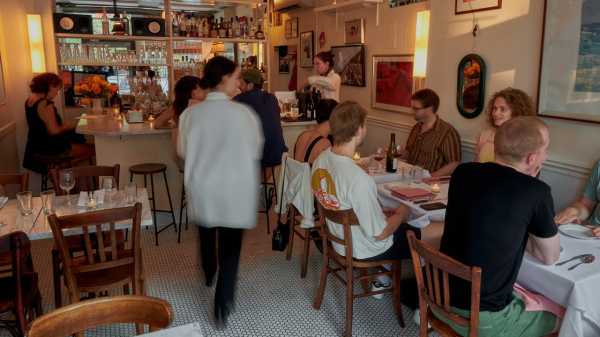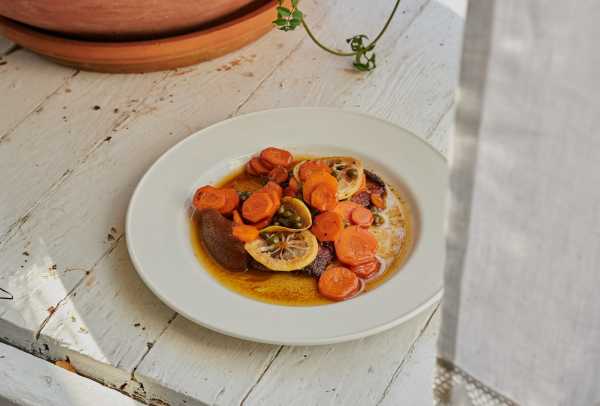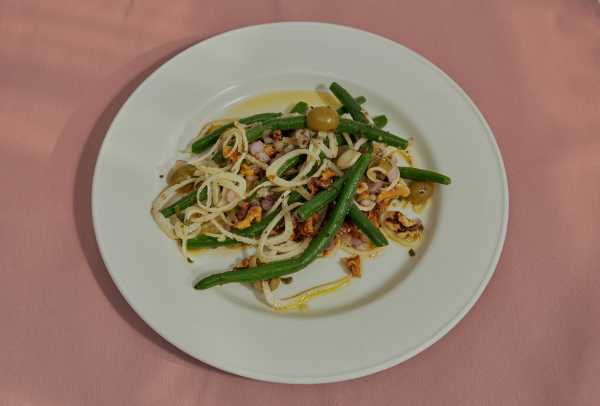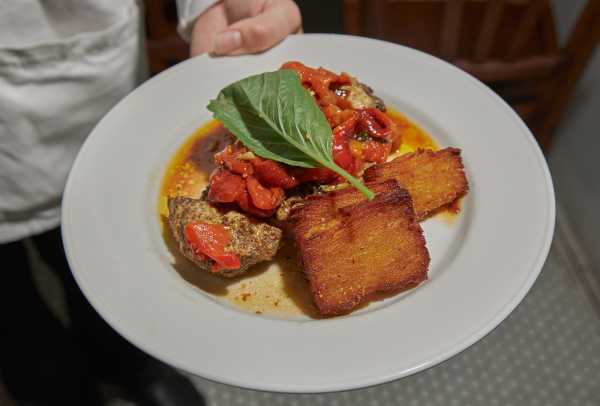
Save this storySave this storySave this storySave this storyYou’re reading the Food Scene newsletter, Helen Rosner’s guide to what, where, and how to eat. Sign up to receive it in your in-box.
I knew I was going to be in for something special at Cafe Kestrel, a tiny slip of a restaurant that opened in Red Hook at the end of June, when I noticed a mysterious quotation on the online menu, next to a somewhat Gothic architectural sketch of churches: “Silflay hraka, u embleer rah.” If you happen to have read the 1972 novel “Watership Down,” a brutal epic about warring tribes of rabbits written by the British author Richard Adams, as I quite coincidentally had recently done, you might recognize the quote as Lapine, a language Adams invented for his rabbit society, whose vocabulary and grammar an attentive reader begins to pick up as the story progresses. The sentence on Cafe Kestrel’s menu is the battle cry of the heroic rabbit Bigwig, shouted in righteous rage at the leader of the enemy tribe of rabbits, at the acme of the story’s great climactic battle. It means, roughly, “Eat shit, you fox-stinking king.”
Cafe Kestrel is housed in a former catering storefront on one of Red Hook’s more commercial drags—which, given the peninsular Brooklyn neighborhood’s relative dearth of public-transit, is still pretty quiet and laid-back. The restaurant belongs to the chef Dennis Spina, formerly of the Metrograph Commissary and before that the quirky River Styx, in partnership with Amanda McMillan, a general manager at The Four Horsemen, in Williamsburg, who handles business operations. The dining room is small by any standard; it’s white-walled and softly lit, with an earnest, New England-ish chair rail running the perimeter, above which hangs an idiosyncratic hodgepodge of fine art, knickknacks, and a framed B. Kliban cat poster. (McMillan told me that she and Spina named the restaurant after “Kes,” a beautiful and horribly depressing 1969 film about a working-class English boy who adopts a fledgling kestrel and develops an interest in falconry.) Even when full of people and furniture, the space feels austere, an effect enhanced by the servers’ uniform of tidy white button-up smocks. There are just six tables inside, plus one out on the sidewalk, and four barstools at a desk-size bar. There’s no host or host stand, and dinner at Cafe Kestrel is the sort of meal a person is inclined to linger over, so even if you’re on time for your reservation you’ll probably spend a few minutes hovering on the sidewalk or sitting on the brightly painted bench outside the closed safety gate of the children’s art studio next door.

An entrée of boneless chicken cutlet with roasted lemon, cooked carrots, and sticky smeared dates feels like a hybrid of Italian piccata and Moroccan tagine.

A composed salad of crisp green beans, thinly sliced fennel, and walnuts is made surprising with the addition of dried sage.

A daily steak special is served with crispy, layered potato pavé.
Once you’re tucked into your table, sipping a nice glass of pink wine or a vermouth-forward cocktail, dinner unfolds with the easy, off-the-cuff elegance of a weeknight dinner party. A golden wedge of farinata, a sort of savory chickpea-flour pancake, arrives buried under a riot of marinated whole olives and punchy cloves of garlic; a creamy slice of Caerphilly cheese is plated next to a thick, bloody-magenta blob of rose-petal jam and a few store-bought crackers. (You might, as I did, begin to think wistfully of Prune, the legendary, now-closed restaurant, where the chef Gabrielle Hamilton famously served sardines and mustard with Triscuits.) An order of chilled shrimp consists of two small bowls, one bearing the crustaceans, peeled and plump, and the other, scoops of mayonnaise and pickle relish side by side–an offhand yin-yang of fridge-door condiments that, on a white tablecloth, in candlelight, seems almost unfathomably cool. We’re fully in Hamilton territory now: this is the sort of dish that throws out any normative notions of “fancy” or “restaurant food”; it’s the kind of confident swing that only works if what lands on the table is absolutely right and true. Say what you want about the merits of cocktail sauce, or a spritz of lemon; I now believe that nothing brings out the sweetness and salinity of a big, beautiful, cold shrimp quite like the tartar-sauce-ish combo of mayonnaise and pickle relish, and it’s awfully exciting to realize you’ve found a chef who understands that.
Spina’s menu, over all, evokes both a relaxed English modernism (with notes of the London gems Cafe Deco and Rochelle Canteen) and the earnest global-pantry bohemia of potluck night in the comp-lit department. A slice of scallop terrine, velvet-sweet meat loosely bound with chunks of potato in a gently briny aspic, is dolloped with crème fraîche and draped in a cilantro salsa verde. A standout entrée of boneless chicken cutlet brings together briny capers, sweet and deep roasted lemon, an orange confetti of tender cooked carrots, and sticky smeared dates, creating something that feels like a hybrid of Italian piccata and Moroccan tagine. A beef carpaccio features the edges of the tender meat seared tataki-style and an aromatic accompaniment of green leeks and toasty pine nuts; it’s buried under a crispy pile of what the menu called pommes gaufrette, but which I, Fanny Brice-ishly, consider to be waffle-cut potato chips. The kitchen makes striking use of herbs, especially (and somewhat surprisingly) those of the dried variety. An appetizer of petal-pink, barely cooked yellowfin tuna, strewn with pickled onions and slivers of cucumber, was dusted with dried oregano, sweet and incense-like. A composed salad of crisp green beans, thinly sliced fennel, and walnuts was made strange and almost wondrous with the pine-needle greenness of dried sage. On one of my visits, I spotted another table rejoicing over the grilled steak of the day, a New York strip piled with hunks of raw, juicy heirloom tomatoes, served with crispy cubes of potato pavé, each intricately layered like an ultra-fine gratin. When I ordered the steak myself, a few days later, Spina had dropped the tomato in favor of gorgeous marinated sweet peppers, including a velvety, lipstick-red Jimmy Nardello. (It’s currently served with braised Romano beans, though by the time you read this it’s likely to be something else entirely.) The meat was rubbed down with a seasoning blend that made judicious, almost artistic use of caraway seed, whose dark, licorice-tinged intensity lingered like the drone note of a bagpipe.
Helen, Help Me!
E-mail your questions about dining, eating, and anything food-related, and Helen may respond in a future newsletter.
Despite the forcefulness of that quote on the menu, Cafe Kestrel isn’t rough or confrontational, except in its striking sense of specificity. Spina, who has a background in fine arts, seems to be cooking for his own enjoyment, rather than trying to pander to yours and mine. In a city of largely interchangeable Little Gem salads and cacio-e-pepe carbs, it’s a pleasure to encounter an utterly self-assured, highly personal point of view. The idiosyncratic charm of the place is enough to smooth out any of the rough spots (like a “v. cold Martini” that was, more than once, not v. cold at all). There’s a weekly special of vegetable curry on Sunday nights; when I went, it was a pleasingly unpretentious zucchini mush that a server described as “sort of Sri Lankan.” A somewhat incongruous side order of macaroni and cheese was excellent, made with enormous, curvaceous noodles liberally bathed in bechamel. The signature dessert, on a brief sweets menu featuring nothing but hits, is a towering sundae of vanilla ice cream and applesauce under a mountain of whipped cream, inspired by an East German specialty of dubiously Swedish origin. On each of my visits, I had a moment of feeling overjoyed by my meal, by the room, by the tactile sense that this was food cooked by a person who had big, bewitching ideas about dinner and how to serve it. In the mood for soup? Spina only makes it, per the menu, “when it’s storming.” ♦
Sourse: newyorker.com